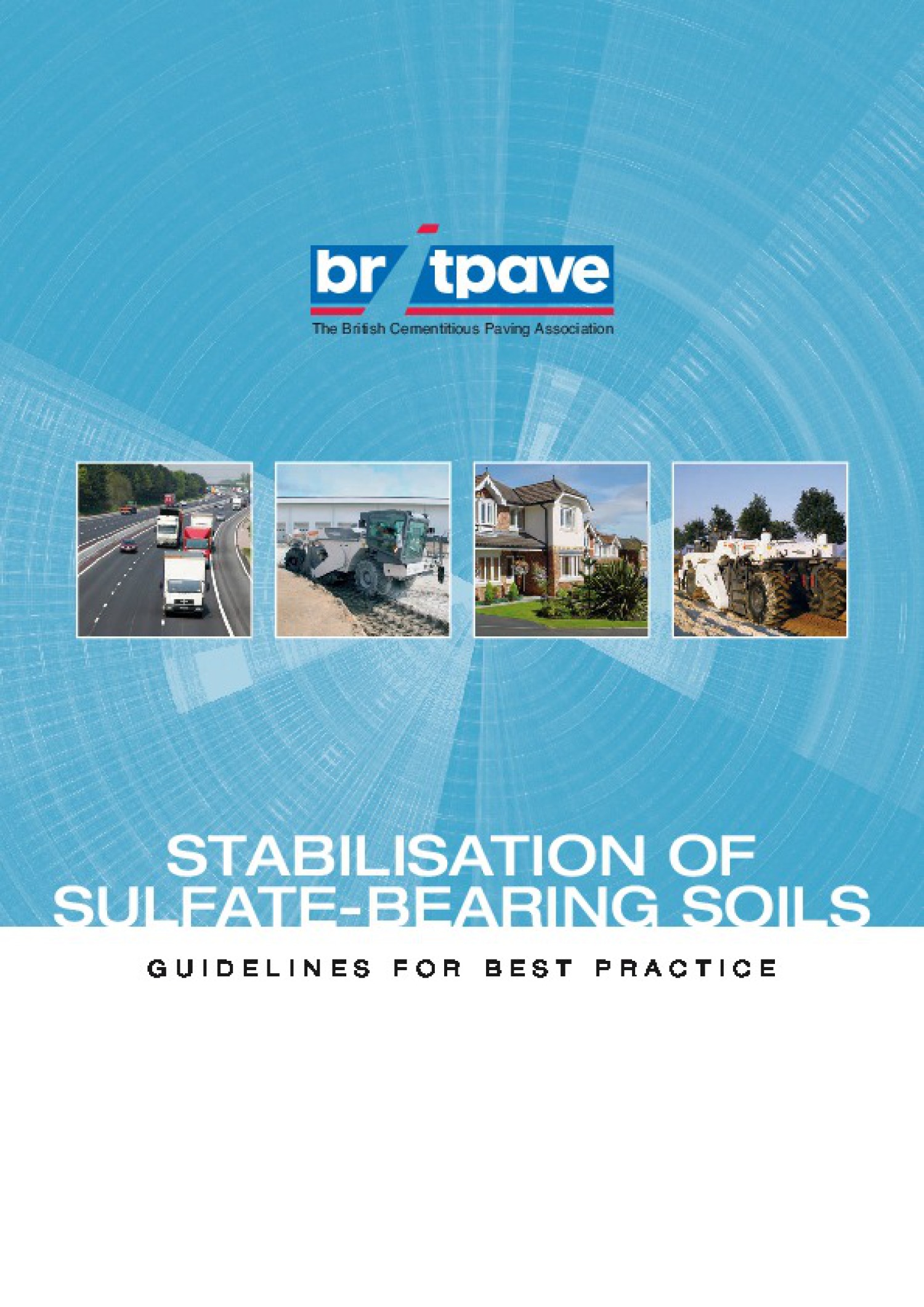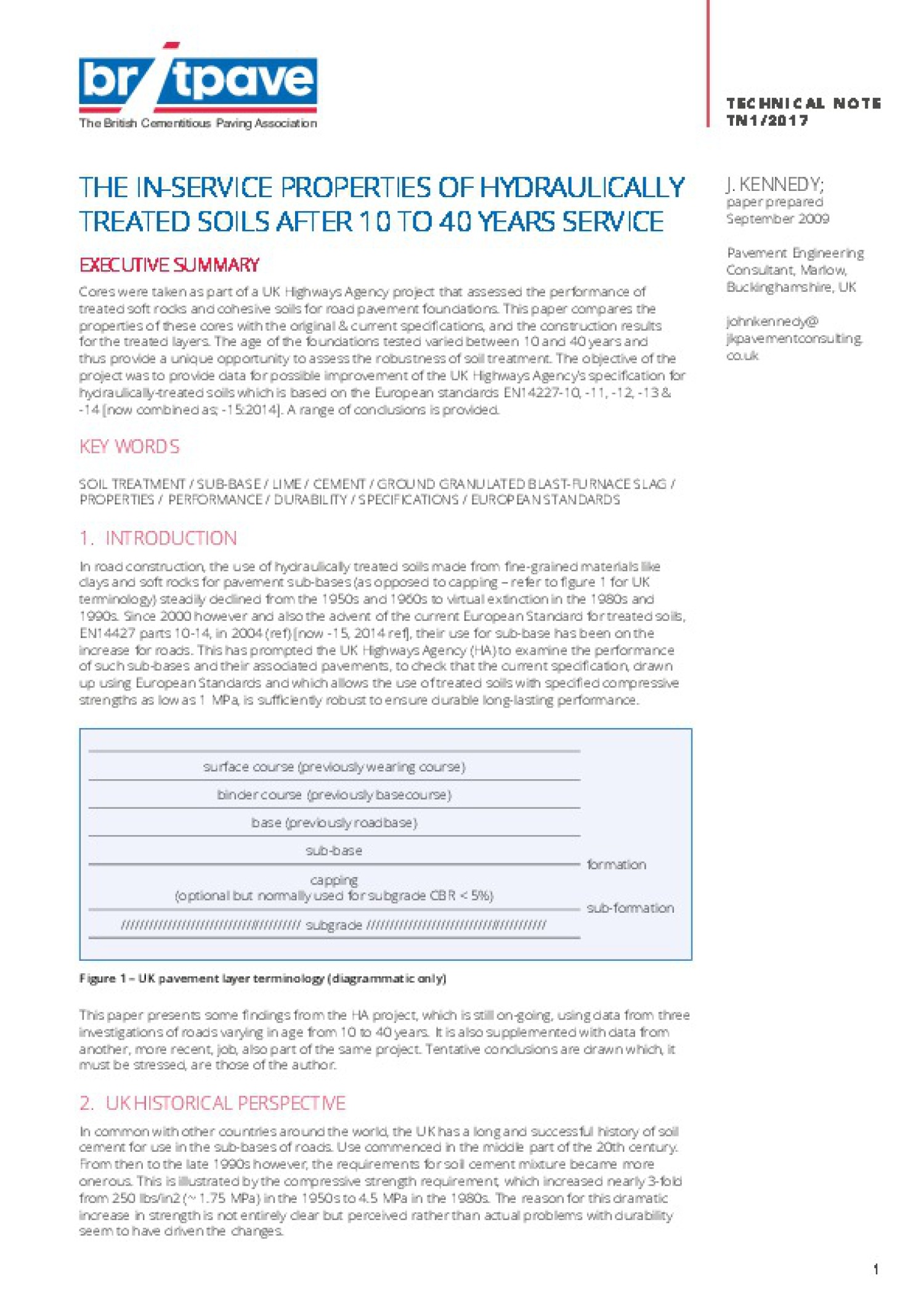Publications
For downloads of Britpave publications click on the download button. Then go to our check-out trolley - the shopping trolley icon top right-hand corner.
By downloading Britpave publications you are agreeing to be placed on our mailing list for news of new publications and industry initiatives. To unsubscribe email: info@britpave.org.uk
To access publications on specific infrastructure types click on the relevant infrastructure tab.
-
Stabilised soils as a subbase or base for road and other pavements

Gives guidance on the two-stage stabilisation of cohesive soils, such as clay, using lime followed by cement, pfa and/or ggbs to produce a strengthened sub-base or base. Covers specification, site investigation, mix design, construction and testing. Pub. 2004
£10.00** Free to Britpave Members
-
Cement and other hydraulically bound mixtures

Describes the European standard BS EN 14227 issued in November 2004 that covers hydraulically bound mixtures for road and other pavements. Explains how the new mixtures compare with those specified for use before that date and gives guidance on their selection and specification. Pub. 2005
£10.00** Free to Britpave Members
-
HBM and Stabilisation 3 - Heavy-Duty Paving

Provides design and specification guidelines for clients, designers and contractors wishing to use hydraulically bound mixtures for heavy-duty paving in areas subject to wheel/axle loading in excess of that permitted on public roads. Also covers mixture design, construction and control testing and includes a useful glossary of terms. Pub. 2007
£10.00** Free to Britpave Members
-
HBM and Stabilisation 2 - Residential and Commercial Road Pavements

Provides design and specification guidelines for clients, designers and contractors wishing to use hydraulically bound mixtures for residential and commercial road pavements. Also covers mixture design, construction and control testing and includes a useful glossary of terms. Pub. 2007
£10.00** Free to Britpave Members
-
HBM and Stabilisation 1 - Parking Areas and Hardstandings

Provides design and specification guidelines for clients, designers and contractors wishing to use hydraulically bound mixtures for parking areas and hardstandings. Also covers mixture design, construction and control testing and includes a useful glossary of terms. Pub. 2007
£10.00** Free to Britpave Members
-
Guidelines for stabilisation of sulfate-bearing soils

These guidelines for the stabilisation of sulfate bearing clays are based on current knowledge and experience. They aim to explain the mechanisms that cause sulfate heave, recommend methods for sampling and testing for sulfates and sulphides and describe measures to minimise the risk of sulfate-related disruption. This publication is an update of the original version, which was published in 2005. Pub. 2011
£10.00** Free to Britpave Members
-
The In-Service Properties of Hydraulically Treated Soils After 10 to 40 Years Service

Cores were taken as part of a UK Highways Agency project that assessed the performance of treated soft rocks and cohesive soils for road pavement foundations. This paper compares the properties of these cores with the original & current specifications, and the construction results for the treated layers. Pub. 2017
£10.00** Free to Britpave Members
-
Comparison of 3 Swell/Stability Tests on Clay Soils Treated with Lime, Cement and GGBS - released December 2013

This report reviews the test methods used to assess the potential for treated/stabilised soils to swell or disintegrate because of the presence of sulfates or sulphides in the soil. Pub. 2013
£10.00** Free to Britpave Members
-
Soil Improvement and Soil Stabilisation - Definitive Industry Guidance

This document is an introductory and technical guide to mix-in-place soil improvement and stabilisation. It outlines industry best practice and provides technical information plus signposts to industry standards and further reading. Revised 2019. Pub. 2019
£10.00** Free to Britpave Members
-
Soil improvement and stabilisation - the proven benefits

A range of project, product and site cases studies proving that implementation of industry best practice will deliver the environmental and cost benefits of soil stabilisation. Pub. 2020
£10.00** Free to Britpave Members
-
Making the case for Soil Stabilisation

Making the case for the use of soil stabilisation by highlighting the range of environmental and economic benefits. Pub. 2021
£10.00** Free to Britpave Members
-
Soil Stabilisation for commercial and industrial projects

The use of soil stabilisation can cost effectively and sustainably can turn previously disregarded sites into viable options for commercial and industrial developments. The civil engineering technique can strengthen poor or unsuitable soils on site without having to dig-and-dump unwanted soil elsewhere and import new aggregates. The report includes Britpave member project case studies.
£10.00** Free to Britpave Members
-
Environmental benefits of soil stabilisation

This report explains the environmental benefits of using soil stabilisation. Not least of which is the rehabilitation of brownfield land to reduce the pressure to build on greenfield sites, reduced use of virgin aggregates, reduced landfill, reduced lorry traffic. Pub. 2022
£10.00** Free to Britpave Members
-
Case Study - Forwarding the use of soil stabilisation for residential developments

This case study examines the potential that soil stabilisation offers for residential developments on difficult sites. The Gifford Lea retirement village Tattenhall project is one of two firsts: the first documented use of lime to improve soils for a residential development and the first such project to receive a comprehensive industry warranty. Pub. 2022
£10.00** Free to Britpave Members
-
Forwarding Soil Stabilisation

This publication is one of two parts. Firstly, it outlines the benefits of soil stabilisation. Secondly, it provides a number of technical case studies from the HS2 project that demonstrate the potential of soil stabilisation to produce high performance materials for civil engineering use. Pub. 2023
£10.00** Free to Britpave Members
-
Leachability of Stabilised Soils

Reports on research undertaken by Nottingham Trent University in collaboration with Britpave that addressed the misconceptions concerning the leaching potential of soil stabilisation. The tested stabilised soils demonstrated very low permeability, restricted water movement and minimised potential for leaching. The research underlined that the rare instances of high pH water discharge identified in past projects were linked to poor drainage design. Properly designed and executed soil stabilisation presents negligible environmental risk. Pub 2025
£10.00** Free to Britpave Members

